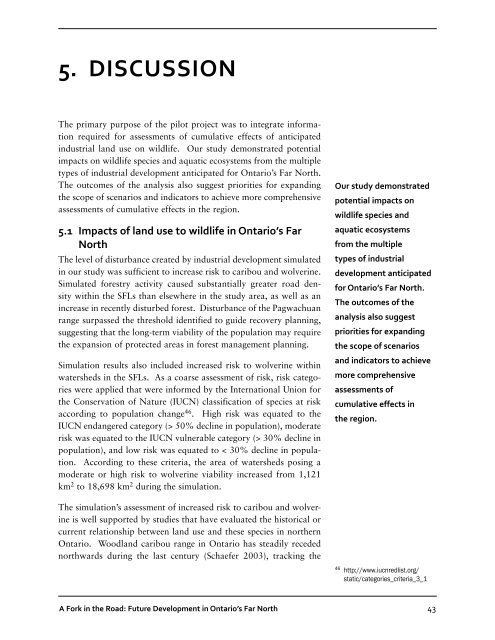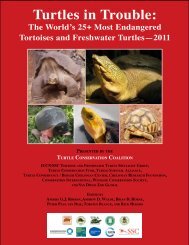Create successful ePaper yourself
Turn your PDF publications into a flip-book with our unique Google optimized e-Paper software.
5. Discussion<br />
The primary purpose of the pilot project was to integrate information<br />
required for assessments of cumulative effects of anticipated<br />
industrial land use on wildlife. Our study demonstrated potential<br />
impacts on wildlife species and aquatic ecosystems from the multiple<br />
types of industrial development anticipated for Ontario’s Far North.<br />
The outcomes of the analysis also suggest priorities for expanding<br />
the scope of scenarios and indicators to achieve more comprehensive<br />
assessments of cumulative effects in the region.<br />
5.1 Impacts of land use to wildlife in Ontario’s Far<br />
North<br />
The level of disturbance created by industrial development simulated<br />
in our study was sufficient to increase risk to caribou and wolverine.<br />
Simulated forestry activity caused substantially greater road density<br />
within the SFLs than elsewhere in the study area, as well as an<br />
increase in recently disturbed forest. Disturbance of the Pagwachuan<br />
range surpassed the threshold identified to guide recovery planning,<br />
suggesting that the long-term viability of the population may require<br />
the expansion of protected areas in forest management planning.<br />
Simulation results also included increased risk to wolverine within<br />
watersheds in the SFLs. As a coarse assessment of risk, risk categories<br />
were applied that were informed by the International Union for<br />
the Conservation of Nature (IUCN) classification of species at risk<br />
according to population change 46 . High risk was equated to the<br />
IUCN endangered category (> 50% decline in population), moderate<br />
risk was equated to the IUCN vulnerable category (> 30% decline in<br />
population), and low risk was equated to < 30% decline in population.<br />
According to these criteria, the area of watersheds posing a<br />
moderate or high risk to wolverine viability increased from 1,121<br />
km 2 to 18,698 km 2 during the simulation.<br />
The simulation’s assessment of increased risk to caribou and wolverine<br />
is well supported by studies that have evaluated the historical or<br />
current relationship between land use and these species in northern<br />
Ontario. Woodland caribou range in Ontario has steadily receded<br />
northwards during the last century (Schaefer 2003), tracking the<br />
Our study demonstrated<br />
potential impacts on<br />
wildlife species and<br />
aquatic ecosystems<br />
from the multiple<br />
types of industrial<br />
development anticipated<br />
for Ontario’s Far North.<br />
The outcomes of the<br />
analysis also suggest<br />
priorities for expanding<br />
the scope of scenarios<br />
and indicators to achieve<br />
more comprehensive<br />
assessments of<br />
cumulative effects in<br />
the region.<br />
46<br />
http://www.iucnredlist.org/<br />
static/categories_criteria_3_1<br />
A Fork in the Road: Future Development in Ontario’s Far North<br />
43







![RaLand / SeaScape [PDF] - Wildlife Conservation Society](https://img.yumpu.com/49974326/1/190x245/raland-seascape-pdf-wildlife-conservation-society.jpg?quality=85)









